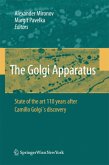The Golgi apparatus (GA) is typically comprised of a series of five to eight cup-shaped, membrane-covered sacs called cisternae that look something like a stack of deflated balloons. The GA is often considered the "distribution and shipping department" for the cell's chemical products. This book traces the first 100 years of GA discovery from the first published accounts from Pavia, Italy, in 1898 to the Centenary Celebration in Pavia, Italy, in 1998 to our most recent discoveries. It summarizes the past 50 years beginning with the modern era of GA discovery, leading up to the present era with almost exclusive focus on molecular biology.
The Golgi Apparatus: The First 100 Years traces the first 100 years of Golgi apparatus discovery from the first published accounts from Pavia, Italy in 1898 to the Centenary Celebration in Pavia, Italy in 1998 and into the decade beyond. It is not intended, however, to be a comprehensive survey but rather to present the perspectives of the authors to summarize their contributions over the past 50 years in parallel with the modern era of Golgi apparatus discovery initiated in 1954 and made possible by the advent of the electron microscope. Included are methods of cell fractionation and biochemical analysis leading up to the present where efforts focus heavily on molecular biology. Topics where the authors and their colleagues have made substantial and/or pioneering contributions are emphasized including Golgi apparatus morphology and structural organization and function (especially in plants), the existence and importance of cisternal tubules, development of methods of plant and animal Golgi apparatus isolation and subfractionation, biochemical analyses of highly purified plant and animal Golgi apparatus fractions in comparison to equally highly pu- fied reference fractions.
The Golgi Apparatus: The First 100 Years traces the first 100 years of Golgi apparatus discovery from the first published accounts from Pavia, Italy in 1898 to the Centenary Celebration in Pavia, Italy in 1998 and into the decade beyond. It is not intended, however, to be a comprehensive survey but rather to present the perspectives of the authors to summarize their contributions over the past 50 years in parallel with the modern era of Golgi apparatus discovery initiated in 1954 and made possible by the advent of the electron microscope. Included are methods of cell fractionation and biochemical analysis leading up to the present where efforts focus heavily on molecular biology. Topics where the authors and their colleagues have made substantial and/or pioneering contributions are emphasized including Golgi apparatus morphology and structural organization and function (especially in plants), the existence and importance of cisternal tubules, development of methods of plant and animal Golgi apparatus isolation and subfractionation, biochemical analyses of highly purified plant and animal Golgi apparatus fractions in comparison to equally highly pu- fied reference fractions.









